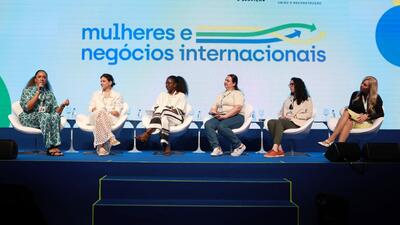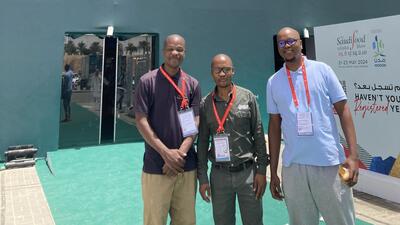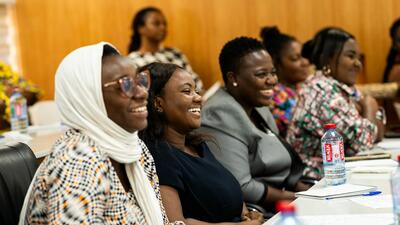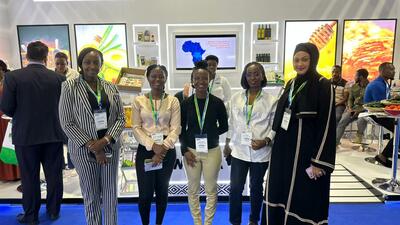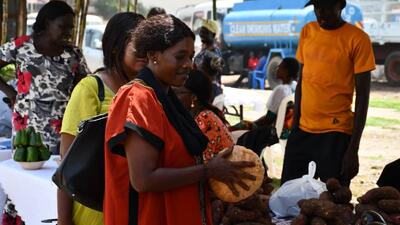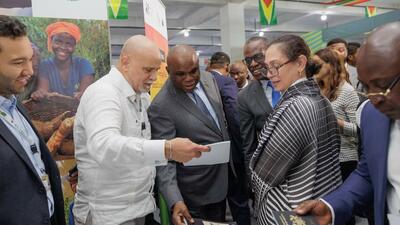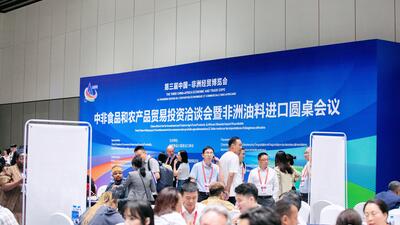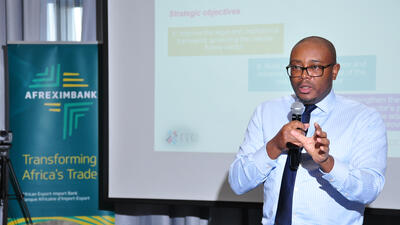Q&A with Enhanced Integrated Framework Executive Director Ratnakar Adhikari
Enhanced Integrated Framework (EIF) Executive Director Ratnakar Adhikari speaking with International Trade Forum Editor Miklos Gaspar. © ITC
Ratnakar Adhikari took over as Executive Director of the Enhanced Integrated Framework (EIF) in October. The US$ 250 million programme assists the integration of least developed countries (LDCs) into the global trading system, increasing their exports, and generating sustainable, trade-based economic growth. EIF works with 47 LDCs and receives contributions from 23 donor countries. Adhikari brings 16 years of experience in trade development to the position. He spoke with International Trade Forum at his office at the World Trade Organization’s headquarters at the end of October.
Q: Why should LDCs prioritize trade in their development strategies?
LDCs have to rely on trade for their growth prospects given the small size of their domestic markets. This is why it is important for them to integrate trade in their development strategies.
Several LDCs already have more open economies than many developing countries. But despite this they have not been able to achieve significant growth in the past few years and their total share of global trade is around 1%. They seem to be in the process of being marginalized in global trade, and in order to reverse this, they need to proactively harness the potential of trade and development. Trade mainstreaming is a starting point.
Q: It is now clear that most LDCs will miss their Millennium Development Goal (MDG) targets. In light of this, what should the international community do? What should LDCs do?
Several LDCs have already achieved the MDGs or are on track to achieve them, but the majority likely will not. What the international community can still do in the coming two years is provide more in terms of resources, market access and technology.
LDCs, for their part, should utilize the two-year period to learn from other LDCs that are meeting the MDGs and try and mobilize resources in order to achieve some of the objectives.
The EIF assists the integration of LDCs into the global trading system, thereby increasing their exports and generating sustainable, trade-based economic growth. © WTO/EIF
We need to make the international commitments more binding. LDCs should also put in resources of their own in order to achieve these objectives and they should not only rely on the international community. Also, there are some critical elements missing from the MDGs, such as technology: how to help LDCs acquire, generate and adapt technology in order to harness the true potential that they have. This is something the post-MDG development framework should include.
Also there should be more binding commitments on market access and on Aid for Trade, as well as on facilitating the flow of foreign direct investment through fiscal incentives to enterprises and on migration, an issue that has been overlooked.
Q: You mean guest worker programmes?
This would be in the context of the World Trade Organization services waiver, how to operationalize the waiver to enable LDCs to take advantage of the possible market opening in the services sector. What I am talking about is somebody from an LDC going to a developed country for employment opportunities for a temporary period. This is a win-win situation for the host country as well as the LDCs sending workers.
Q: According to a recent paper by the Fondation pour les études et recherches sur le développement international, ‘EIF procedures are quite detailed and bureaucratic’ and ‘this explains the rather slow place of disbursements from the Trust Fund, which in turn does not provide an incentive to donors to renew their contribution.’ Do you think that the speed of decision-making represents a bottleneck to EIF efficiency? If so, what do you plan to do to address this?
The speed of decision-making is not a problem at all. Let me clarify that once the final proposal is received the decision is made within 20 working days. What is delaying the process is that there is a lot we need to do before the proposal is up to a standard such that it can be submitted to the board.
Our intention is not merely to disburse funds. We want to build the capacities of the countries to develop proposals so that they can mobilize resources not only from the EIF mechanism but other donors. In order to be able to bring them to a particular level, it takes time.
We have noticed that the learning curve has been fairly steep: for the countries submitting second and third proposals, there is much less back and forth and the process takes a few weeks rather than several months.
The first achievement is the institutional structure that has been put in place in more than 30 countries for the conducting of needs assessments, and based on the identification of needs, the mobilization of Aid-for-Trade resources.
We could do more leveraging of resources: we want to see these countries mobilizing additional resources from other bilateral or multilateral donors as well as providing resources from their own treasury in order to make the programmes more sustainable. If they could also mobilize resources from the private sector, that would be even better.
Also, LDCs need to promote regional cooperation and regional integration. LDCs have not been able to utilize the market access opportunities they have been offered by regional trading arrangements. The main issue here is connectivity and their inability to meet the relevant standards. In order to help them overcome the challenges we should provide whatever support we can within EIF.
Another aspect is that LDCs have been left out of global and regional value chains: how to help LDCs plug themselves into global value chains is something we should look at in terms of EIF funding. We talk about how to help LDCs move up the value chain, but we do not talk much about how to help them integrate. This is something we would like to focus on in the future.
Q: The EIF is expected to come to completion in the next two years. Should the programme be extended? Do you see donors willing to top up their pledges to EIF? How would you imagine a successor programme to EIF?
Last year’s Mid-Term Review of the EIF showed that the programme remains relevant for LDCs, even as EIF countries are at different places on their journey. LDCs have thus expressed strong interest in continuing the programme beyond 2015. Some donors are also willing to extend their support. Future work could entail upscaling the mainstreaming of LDC trade at the sector level and LDC integration into global and regional value chains.






